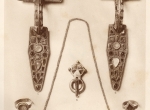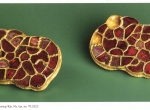Polychrome Style
Polychrome style (polychrome jewellery), ornamentation style in use during the →Migration Period and the Merovingian period across much of Europe – from the Caucasus and the Black Sea region through the Danube area as far as western Europe and Britain. It combines the late Hellenistic and provincial Roman tradition with barbarian →Barbaricum artwork, also nomad. The style possibly emerged in the goldworking centres of the Bosporan Kingdom (eastern Crimea and Taman Peninsula) or on the territory of modern Georgia. P. style was used mainly in ornamenting brooches but is seen also on horse harness, saddle fittings, weapons, diadems and other dress accessories. In the P. style surfaces of gold objects are decorated with precious or semiprecious stones, usually dark red almandines (red garnets - fig. 1-3.). These stones (and also pieces of glass) were set within strips of gold foil, surrounded with filigree and granulation (fig. 1-2.). In the cloisonné technique the gemstones or glass were set in compartments of soldered strips of metal foil, separated with filigree wire, over a strip of metal foil.
AB-W
Literature: I.G. H. Roth, Kunst der Völkerwanderungszeit, Propyläen-Kunstgeschichte, Supplementband 4, Frankfurt a.M. 1979;B. Arrhenius, Merovingian Garnet Jewellery, Göteborg 1985; H. Roth, Kunst und Handwerk im frühen Mittelalter, Stuttgard 1986; Damm, Goldschmiedearbeiten der Völkerwanderungszeit aus dem nördlichen Schwarzmeergebiet, Katalog der Sammlung Diergardt 2, Kölner Jahrb. für Vor- und Frühgeschichte 21, 1988, s. 65-210; I.A. Bažan, M.B. Ščukin, K voprosu o vozniknovenii polichromnogo stila klauzonne epochi velikovo peresselenija narodov, “Archeologičeskij Sbornik” 30, 1990, p. 83-96; M. Mączyńska, Światło z popiołu. Wędrwówki ludów w Europie w IV i V w., Warszawa 2013, p. 101-105.
-
 full resolution
full resolution
Fig. 1. Ornaments and dress accessories from the burial at Untersiebenbrunn (W. Kubitschek, Grabfunde in Untersiebenbrunn (auf dem Marchfelde), „Jahrbuch für Alterumskunde“ 5, 1911, Plate I).
-
 full resolution
full resolution
Fig. 2. Brooches from the Bavarian cemetery at Pocking-Inzing (Epocha Merovingov. Europa bez granic. Merowingerzeit. Europa ohne Grenze. The Merovingian Period. Europe without borders, München 2007, Fig. 7, p. 191).
-
![Fig. 3. Laa an der Thaya, Lower Austria (W. Menghin, Germany, gunny i awary na Srednem Dunae. Germanen, Hunnen und Awaren an der mittleren Donau. Germans, Huns and Avars on the middle Danube, [in:] Epocha Merovingov. Europa bez granic. Merowingerzeit. Euro](http://www.mpov.uw.edu.pl/userfiles/pl/generated/thumbs/150x110_1/Badania/Thesaurus/stylpolichromicznyryc.3.jpg) full resolution
full resolution
Fig. 3. Laa an der Thaya, Lower Austria (W. Menghin, Germany, gunny i awary na Srednem Dunae. Germanen, Hunnen und Awaren an der mittleren Donau. Germans, Huns and Avars on the middle Danube, [in:] Epocha Merovingov. Europa bez granic. Merowingerzeit. Euro


